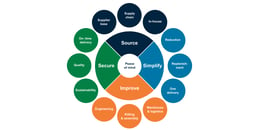- Insights
- The Solutionists Hub
- Supply Chain Management Risks, and How to Handle Them
Supply Chain Management Risks, and How to Handle Them

You don’t need to be an industry veteran to understand that global supply chains are currently facing huge amounts of strain. Every day, the headlines are full of stories about companies like yours struggling to meet customer demand due to long lead times, high prices and low availability of essential C-parts and other components.
Even if the media attention has cooled off in recent months, these issues are still a reality.
Other global issues such as inflation and the high costs of fuel and energy are also contributing to the problem, and making life difficult for manufacturers both in terms of reduced C-parts availability and spiraling costs.
However, there are a number of other supply chain risks that have an effect on manufacturing companies, and some of them will continue to be a reality even after the worst of the current disruptions is over.
In this article, I’ll present a few risks that companies like yours typically deal with and provide a few courses of action that can reduce their impact – even if they can’t be eliminated entirely.
Having too few options
It’s always going to be risky to have no alternatives to your existing suppliers. Having a backup is essential if you want to prevent your operation grinding to a halt if your supplier should run into trouble. There’s many reasons why a supplier can face disruptions to its operations, and if you’re too reliant on this one supplier for a part of your C-parts needs, their problems very quickly become your problems.
Regardless of the global situation, this is always going to be a supply chain risk for a manufacturer. But it’s not an argument for suddenly picking up the phone and sourcing lots of new, alternative suppliers – I’ve written about the issues that come with having too many suppliers before, and those effects can be just as negative. But having some level of redundancy in your supply chain is always smart – and in most cases, you’d be better off working with a supply chain partner who can take care of these supplier relationships for you.
Long lead times, high prices and high MOQs
These three risks have affected manufacturers for a long time, but they’re especially challenging at the moment. If you’ve tried to buy a car recently, you’ll know that lead times have got longer at a drastic rate over the last couple of years. Suddenly, companies like yours are having to wait a long time for basic parts that were readily available in the recent past.
Prices have also climbed, for a number of reasons – and even if the purchase price of C-parts is still relatively insignificant, TCO has also got higher. On top of all this, high MOQs are tying up capital and shrinking the supplier pool for already-struggling manufacturers.
Naturally, risks like these need to be weighed against each other. If you can’t deal with year-long lead times for a shipment of essential parts, you will probably have to pay a higher price. Alternatively, if the lead times are less important, you may be able to get a better price, or a lower MOQ. The trouble is, it’s challenging to make this analysis for every item you manufacture. And it’s even more difficult to make these negotiations with individual suppliers. In cases like these, the benefits of having a supply chain partner who can take care of sourcing for you become obvious.
Regulation
As time goes on, it’s likely that state regulations, both at home and abroad, are going to become more of a thorn in the side for manufacturers. Earlier this year, the EU increased the duty on certain types of fasteners imported from China as part of its anti-dumping measures, and more changes like this are sure to follow. This creates increased costs for manufacturers, but it also shakes up the market – with the introduction of these new duties, many European companies began looking for European suppliers, which naturally caused these suppliers’ prices to increase.
It's difficult for even a large manufacturing company to stay updated on all the impacts that new international regulations might have on their business – so this is yet another risk that can be mitigated by working with a supply chain partner.
Highly specific parts
In times like this, when even basic parts can be hard to get hold of, it can be risky to have lots of uncommon, highly-specific parts in your products. If your product designs rely on a more unique component from a specific manufacturer, rather than a more generic alternative, you’re tying yourself to a single supplier. And when any of these other risks pop up in your supply chain, you risk not being able to get the parts you need.
Sometimes, it’s impossible to avoid parts like this. Some products will always require unique, custom-made components. But to minimize the associated risks, it’s always a good choice to bring in your supply chain partner as early as possible in the design process, so that they can advise you on the best choice of components based on the requirements and limitations of your supply chain.
Shipping disruptions
The problems in international freight are particularly topical at the moment – issues like ports shutting down or operating at lower capacity, staff shortages and blockages in global shipping routes over the last few years have shown how fragile global supply chains really are.
Many European companies have felt the effects and are considering switching to suppliers that are closer to home – but it’s never easy to switch suppliers, and once a company has made the decision to do it, it doesn’t happen overnight. What’s more, many European suppliers are themselves reliant on suppliers in the Far East. If you’re a global company, you can’t simply negotiate your way out of global problems.
Again, the benefits of bringing in a supply chain partner become obvious with this in mind. If anything, the last two years have shown that these big players are in the best position to weather the storm. With a worldwide base of suppliers, they’re much better equipped to source alternative suppliers than any manufacturing company that handles supplier relations itself.
Why it’s time to get a supply chain partner
I hope this article shows that with the multitude of risks present in modern supply chains, ensuring C-parts availability is best achieved with the help of a supply chain partner – and despite the difficult global situation, now may be the time to look for one. With almost all manufacturers facing similar challenges, a company that switches to a supplier that can more reliably get the required parts for the right cost at the right time can gain a significant advantage over the competition. And while the issues we experience today may not last forever, new ones are just around the corner – so choosing a truly global partner who can give you the options you need is a wise investment for the future.
For more insights into C-parts supply chain management, make sure to read our in-depth guide on the topic and subscribe to The Solutionists Hub – you can also download a separate PPT, The Guide to a Seamless Supply Chain of C-Parts, by clicking the button below.
Additionally, if you’re currently looking for a partner that can help your company manage these kinds of risks, you can get in touch with one of our experts here.
Get new knowledge every week!
Related
-
By Niklas LindsköldHow do EU sanctions against Russia affect your C-parts operation?
-
By Jaroslaw BazeliSupply Chain Strategy Definitions You Should Know
-
By Nick MilesDefining the Objectives of C-Parts Supply Chain Management
-
By Rob KoningsHow Does the C-Parts Supply Chain Management Process Work in Practice?
-
By Jacob BergströmSupply Chain Challenges and How to Overcome Them
-
By Sergio BrambilaSustainable Supply Chain: How to Reduce Your Carbon Footprint
-
By Jacob BergströmSupplier vs. Supply Chain Partner: What to Choose?










